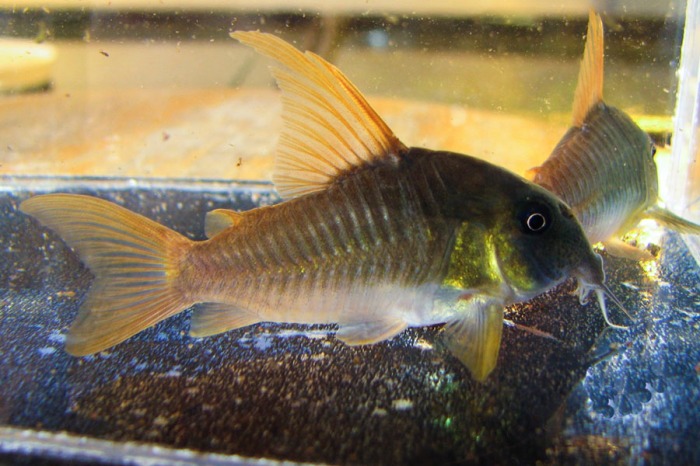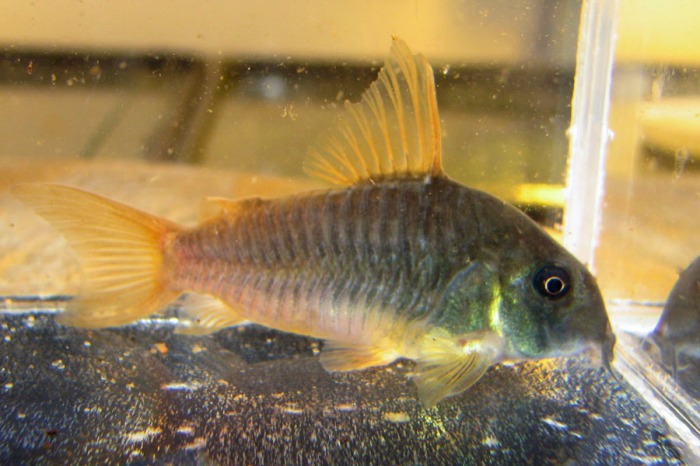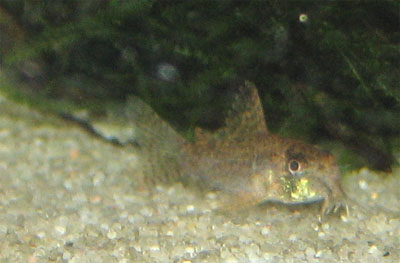Introduction

Corydoras concolor was described by Stanley Weitzman in 1961. It is one of the dwarf armoured catfish from South America that have become increasingly popular over the last few years. Small and peaceful it makes an ideal fish for a community tank or an excellent breeding challenge for an advanced hobbyist.
Distribution & Availability
C. concolor is found in the Orinoco river system in Venezuela and Colombia. It is available only occasionally in shops either as a wild caught import or as a product of some hobbyist’s breeding effort. It’s not that expensive being just slightly dearer than the common bronze and pepper corydoras.
Description
Males – a small catfish with typical corydoras profile of arched back and flat underside. Males will reach about 5.5cm only. Colour is slate blue (from which it derives the common name – slate cory) with an emerald-green sheen over the operculum (gill covers). Specimens in good condition develop a rusty orange wash over the rear half of their body and on their unpaired fins. A dark eye mask can just about be made out in some lighting conditions. Males have a high dorsal fins which in mature animals can reach an impressive length. This is a stunning fish which in no way deserves the name given to it – concolor means “of one colour”.
Females – up to 6cm and similar to the male but fuller bodied. Does not develop the exaggerated dorsal finnage of the males.
Requirements
Easy to keep in most water conditions, just avoid extremes of pH and temperature. Suitable for a planted community tank of peaceful fish. Like most Corydoras species they are less shy and show more natural behaviour when kept as a group. Six or more is ideal.

- Tank size: 90cm minimum
- Decoration: hiding places constructed from slate, bogwood and plants. Provide a thin covering of river sand in preference to gravel.
- Temperature: 22 – 26oC
- pH: 6 – 8
- Hardness: not too hard, 2 – 25odH
Feeding
Feed a variety of sinking pellets and frozen food. Offer a treat of live food once or twice a week. If kept in a community tank it is a good idea to feed your catfish after the lights go out.
Breeding
These fish are not the easiest of Corydoras to breed and can be a bit of a challenge to get going. Once they’ve started though they can spawn continuously for a period of several weeks producing scores of fry.
Condition a group of 2 females and 4 males on live and frozen foods such as frozen bloodworms, frozen blackworms, live daphnia and white worms. Decorate the tank with pieces of bogwood and provide clumps of fine-leaved plants such as Indian fern, Java fern and Java moss. A covering of floating plants will reduce their tendency to be shy.
Keep the water quality first-rate and provide some gentle water movement in the form of an air-powered sponge filter. Monitor the pH and make sure it’s no more than 6.0 or even a little less. The hardness should be 1 or 2 degrees only.
The adults will spawn amongst the fine-leaved plants, the males will court the females by dancing in front of them and attempting to clasp them. The females will resist until they are ready when they will allow their chosen mate to position himself across her in the “Tee” shape typical of Corydoras.

Eggs can be left in the tank as the adults will ignore them. If prefered they can be collected and hatched out in a tub which can be floated in the tank. Add an air stone and a few drops of methylene blue to prevent fungus.
The eggs will hatch in about 4 days and the fry can be fed 2 days after hatching. Fry can be fed on microworm and crushed pre-soaked flake. Change the water in the tub twice a day using water from the main tank. Keep the bottom of the tub wiped clean.
Eggs left in the tank should remain unmolested and the adults don’t actively hunt the newly hatched fry but do eat those they happen across and can catch. Provide hiding places in the form of clumps of Java moss and pieces of wood and most fry will survive.
Spawning video
Summary
C. concolor is a beautiful, peaceful, easy to keep catfish that is perfect for a community tank. It deserves to be more popular.
References
- Fishbase species summary
- Fuller, I. A. M. and H. G. Evers. 2005. Identifying Corydoradinae catfish. Aspidoras–Brochis–Corydoras–Scleromystax and C-numbers.
Exelent article keep up the good work John
LikeLike